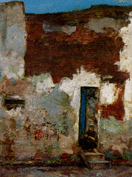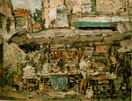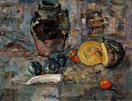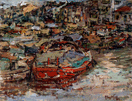THE OIL PAINTING OF CHOH TEE
By Choy Weng Yan, 1985
In the mid-seventies, contemporary art in Singapore entered an exciting new phase of consequence. As a result of concerted efforts, art exhibitions jumped many-fold, art activities proliferated, more substantial art patronage took root, horizons in art appreciation expanded and the range of artistic talents widened considerably, culminating into a fibrant atmosphere poised for artistic growth. Amidst all the developments was an important outcome on the part of the artists themselves: a growing number, concerned about their future as serious practitioners of art and inspired by new possibilities, re-assessed their positions and decided to raise the expectations of their own performances. One of the artists who is fast cutting out a distinct profile for himself against the background of Singapore art is Tan Choh Tee. Within a decade, working at a hectic, relentless pace, he created an impressive number of works characterized by many strengths including a consistency in quality, a singularity of purpose and a freshness of expression.
The ambience of the city particularly the older parts entrenched in their traditions and customs, sights, and sounds, rhythms and movements makes up the overall theme of Choh Tee’s works until recently. The hub of Chinatown with its vitality and energy, the charismatic Singapore River meandering nonchalantly into the city exuding a feeling of remote majesty, a cluster of eating stalls or even an abandoned hidden lonely lane – all these pose challenges to Choh Tee’s artistic acumen. But Choh Tee sees his scenes not as dilapidated buildings or forgotten streets of yesterday but as images composing kinetic forms and shapes, light and colours in all their fleeting moods.
Because of an affinity between them, Choh Tee’s art has often been compared with the art of the French Impressionists who exerted an early influence on him. Like the Impressionists, Choh Tee firmly believes that art must flow out of the artist’s personal experience and that the basis of his art must come from the visual phenomenon he has himself lived through. That is why it is necessary to build a painting on the spot before the subject-matter itself and not contrive it in the privacy of the studio. Again like the Impressionists, his objective in the execution of his painting is to capture the fleeting moments with their changing moods and to freeze them into canvasses of art. Beyond these essentials, Choh Tee has long moved away from the Impressionists’ framework to evolve his own personal style and in the years, has successfully injected into his work ingredients which reflect his own responses, emotions and sensitivity to his subject. For years, his paintings are characteristed by firm, deft strokes applied swiftly building up into an orchestration of subtle, beautiful colours in their most subdued and sublime state. The overall effects, as Choh Tee pits his stamina against the subject to exhaust it, are an overwhelming sense of the painting being in its final resolve. At the same time the material nature of the contents – such as the concreteness of the bricks or the brittleness of worn out paper – is often heightened.
Recently, Choh Tee felt the need to expand the horizons of his artistic vision further. Thus, he changed his approach to his work. He shifted the emphasis from colours to the character of the brush strokes, liberating them to make them more articulate conveying more vitality –an act inspired by the tested techniques of Chinese brush painting practiced within the framework of a formidable tradition. It is on this basis that the work titled ‘Lotus’ or the current still-life studies are made. It is bold and imaginative move typical of Choh Tee’s answer to art, which will, no doubt, in time flower into yet another exciting phase of his art.






